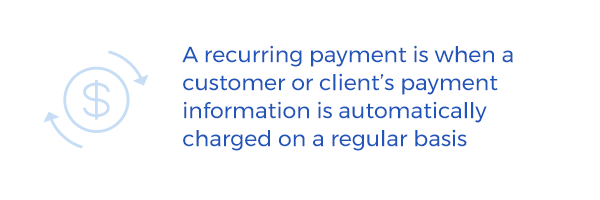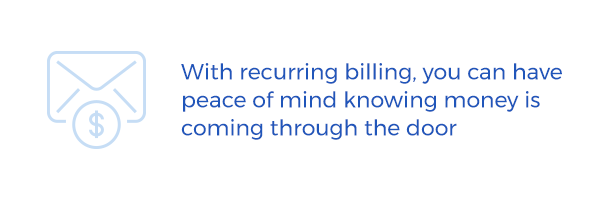Should You Start Accepting Recurring Payments?

The bane of every architect's existence is the prospect of an unpaid invoice. Far too often, architectural professionals will have to spend extra time inquiring about late invoices, sending emails and placing phone calls to check on the status of a payment (if one is heading out the door at all). One way to combat this issue is to take advantage of an online payment solution that offers an automated recurring payment program.
Here, we’ll discuss how recurring payments work, the advantages of implementing them into your business, and how to determine if they are right for your line of work.
What is a recurring payment?
As the name suggests, a recurring payment is when a customer or client’s payment information is automatically charged on a regular basis. Typically, the customer will authorize this form of payment with the merchant and submit their payment information. This information is then stored in the client’s account by the merchant in a secure location. Ideally, if the merchant is using an online payment solution, the payment processor will store this information on the merchant’s behalf, assuming all data security liability.
 With their payment data on file, the merchant can then charge the client at a rate both the client and the merchant agree to. Most recurring payments are set to be charged monthly, but they can also be set up to charge at a variety of set intervals—charges can occur weekly, or even stop after a certain dollar amount has been reached or after a certain date and time.
With their payment data on file, the merchant can then charge the client at a rate both the client and the merchant agree to. Most recurring payments are set to be charged monthly, but they can also be set up to charge at a variety of set intervals—charges can occur weekly, or even stop after a certain dollar amount has been reached or after a certain date and time.
Depending on the software or type of business, recurring payments can be set at either a fixed rate or a variable rate. For example, with a variable rate, a client would be charged based on the number of hours a project was worked on, and would be billed accordingly. Conversely, a fixed rate will always bill the same amount for each charge.
Benefits of recurring payments
So, why exactly should you set your clients up on an automated payment system when you can simply bill them yourself as needed? There are a wealth of benefits to implementing a recurring payment system, which we’ll break down below:
Improve your cash flow
There’s nothing that boosts your bottom line better than a guaranteed payment system. With recurring billing, you can have peace of mind knowing money is coming through the door, allowing you to cover overhead and any other monthly expenses your business may have. Automated payments can lead to more accurate cash flow projections. After all, it’s far easier to forecast profits when you know exactly when they’ll arrive. Considering 70 percent of businesses are not forecasting cash flow accurately, recurring billing can give you a leg up on your competition in this department.

Speed up payment
Naturally, recurring payments also increase how fast your firm is getting paid for your services. With automated payments, your bills will get paid promptly and on-time every time. As such, this means less time is being spent chasing down unpaid invoices and less time spent waiting for a check to arrive in the mail. In turn, your clients don’t have to worry about being late with their payments, allowing your work to continue uninterrupted. It’s a win-win for both parties involved.
Improves customer relationships
Offering automated payments to your clients will also increase their satisfaction with your business. More and more of today’s consumers are paying their bills online through an automated payment plan. In fact, a survey conducted by ACI Worldwide revealed that automated payments among customers rose 62 percent in 2020. Not only can customers “set and forget” their billing, but they can also factor it into their monthly budgeting.
Focus on your business instead of the bill
Wouldn’t you prefer to spend more time working on projects instead of worrying about your cash flow? Set your billing on autopilot! Your clients are charged automatically with little to no action required on your end, and all the transactions are tracked and recorded by your payment processor for you to review at your leisure.
Are recurring payments right for your business?
While recurring payments can have many benefits, it’s not a billing solution that will be a perfect fit for every architect. Its overall usefulness largely depends on how your business operates in the first place.
Where recurring payments are more feasible
If you’re billing hourly, whether by each role your team fulfills or by the activities you perform for a client, a recurring payment system would work quite well for you. You could feasibly draft a contract stating your hourly rates, and invoice your clients on a weekly, bi-monthly, or monthly basis depending on the hours work and the activities performed.
The key, of course, is to work with your client to ensure they agree to the rates you’ll be charging. Since automation is entering the picture, the last thing you want is for a client to be surprised when their payment information is charged automatically with a dollar amount they weren’t expecting.
 One way to minimize this is to put a cap on your hourly billing. You could set your recurring billing to stop charges once a certain dollar amount has been reached. This ensures the client will not be billed a penny more than they expect, and you can work with them to determine when to resume payments (and continue the project at hand).
One way to minimize this is to put a cap on your hourly billing. You could set your recurring billing to stop charges once a certain dollar amount has been reached. This ensures the client will not be billed a penny more than they expect, and you can work with them to determine when to resume payments (and continue the project at hand).
Where recurring payments are less feasible
On the other hand, if your business bills clients based on phases completed, recurring billing may not be the right fit. After all, depending on the type of project, phases may take several months to complete. There’s no sense in setting up a recurring billing cycle if invoices aren’t being produced on a regular, dependable basis.
Likewise, if your business thrives on smaller projects with a clear scope, recurring billing is equally unsuitable. Such projects are typically designed around a fixed fee invoice, where the cost is determined upfront and paid in-full when the project is finished.
In any case, if your firm is able to implement recurring billing, it would be worth the effort to take advantage of it. The convenience you offer to your clients to set and forget their billing, while keeping your cash flow predictable, can have a significant positive impact on your overall success.
Ready to start using recurring billing
Now that we’ve explored the ins and outs of recurring payments and how they can work in your AEC firm, you may find yourself ready to embrace the benefits and convenience that scheduled payments can bring.
The logical next question is: “how do I get started?”
In almost every instance, your first step will be to contact your payment provider and ask them to enable automatic payments / recurring billing on your account. Depending on who your provider is, you may have to pay a one-time or ongoing fee to enable such functionality. However, the best payment solutions will include this functionality at no additional cost, recognizing it as a valuable and essential component of an online payment solution. You might not even have to enable the feature depending on your provider, and you may be able to jump right in and start scheduling client payments in advance.
Regardless of the route to enable recurring billing on your account, once you’re ready to go, you can start working payment schedules into your workflow with clients. You can do this in several different ways: during the onboarding process, while you’re in the middle of working a case, or after a case has ended.
Regardless of when you decide to start a recurring billing profile, best practices will remain the same: 1) you will want to work with your client to establish a billing profile that meets their payment abilities and your needs, and 2) you will want to obtain payment authorization up front to protect your firm in the unlikely event of a payment dispute.
How recurring payments work
Recurring billing profiles are an extremely flexible way for you to accept client payments, and most systems will allow you to set parameters in whatever way is best for you and your client. When getting started, you and your clients will set an initial goal: are you working to pay off a set dollar amount, like a $5,000 upfront payment, or are you looking to create a recurring schedule that runs indefinitely or until a future date, and is not dependent upon a sum total amount being reached.
Once you know the goal you’re working towards, you can move forward with the details of the payment, specifically, building a profile that specifies how often your client’s payment source (card or checking account) is billed, and at what frequency. If you’re working towards a set gross payment amount, this schedule will stop as soon as that payment total is hit. If you create an ongoing profile that isn’t tied to a final amount, the profile will charge your client’s payment method at the interval established until an end date is reached or until you manually end the schedule.
Most systems are created to ensure transparency with both you and your client. As such, for most solutions, you and your client will both receive a notification that a payment has run successfully every time a payment is made through the recurring profile. In more advanced systems, you can also enable automatic notifications that will send your client a reminder email in advance of a scheduled payment running. This increases transparency between your firm and your client, and also gives them a chance to update billing/payments information in the event that any details have changed on their part.
How to implement recurring billing using ClientPay
Here at ClientPay, our goal in all things is to make it as easy as possible for your clients to pay you for your services and for you to get paid—and recurring payments are no different. We’ve included recurring billing in the form of our Scheduled Payments feature on every user account for no additional charge, so you can start creating recurring payments profiles with no effort needed from our team.
To create a Scheduled Payment, simply click on the “Schedule” tab on the left hand menu of the ClientPay dashboard. Now you’re ready to create your Scheduled Payment. First, choose the deposit account you’d like payments to deposit into (only necessary if you have more than one bank account linked to your ClientPay account).
Next, choose if you want to create a one-time future payment, or an ongoing recurring billing schedule. If you only want to choose a one-time future payment, simply enter the date and payment amount you’d like to run. If you’re creating an ongoing schedule, select how frequently you’d like transactions to run (weekly, twice a month, monthly, or yearly), the amount you want to charge, and the date you want the first payment to run. Finally, determine when you want the payment schedule to end. This can be at a set date in the future, once a certain dollar amount is reached in total transaction volume, or you can leave the schedule open to run indefinitely.
With just a few clicks of your mouse, you and your client can simplify the billing and payments process so that transactions run automatically in the background and you both can spend your time and effort focusing on more important matters.
Learn more about how ClientPay’s Scheduled Payments feature can streamline your payments, so you can focus on your clients instead of your billing. Or if you’re ready to get started with ClientPay, click here.